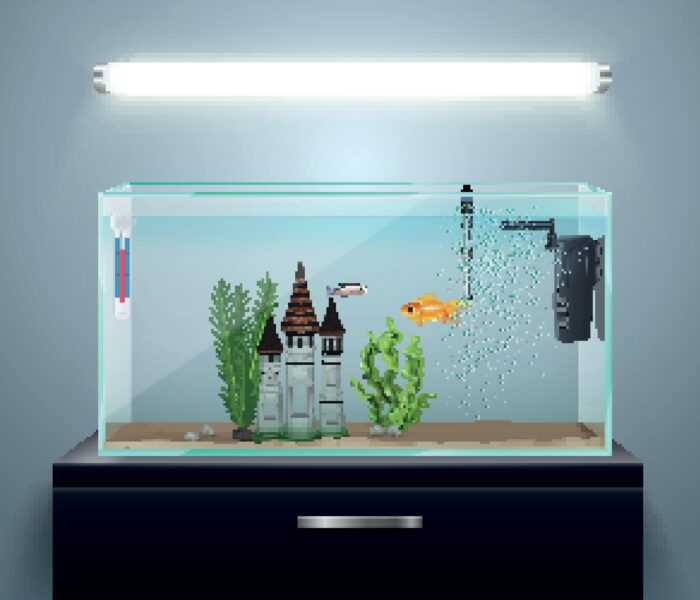It is a little difficult to truly appreciate the peace and tranquility of your fish tank when your air pump sounds like an electric pencil sharpener. At around 45 decibels–about the noise made by your refrigerator–the pump is not offensively loud, if running properly. If it is making more than 45 decibels of noise, there are remedies you can use to quiet it down.
Please keep reading to find some of the most effective and inexpensive ways to quiet your aquarium pump.
 Aquarium with Air Pump Bubbling
Aquarium with Air Pump Bubbling
6 Causes of–and Cures for–a Loud Air Pump
45 decibels is about the top end noise a pump will make when it is new. Age and/or some of the other things in this list can make it louder. By using one or more of these suggestions you should be able to return your aquarium and room to a peaceful oasis.
1) Pump Location #1
Try to position the air pump higher than the aquarium’s water surface. This will accomplish 2 things for you. It will make the pump quieter and it will prevent water from siphoning out of the tank if the pump quits. Place the pump on a small stand or shelf close to the aquarium and hook it up.
Make sure that the pump is located far enough from the aquarium so it cannot fall in. The pumps are not waterproof and water is a great conductor of electricity. Chances are good that you will have to replace all of your fish if the pump dives in.
1a) Pump Location #2
Make sure that your pump is located on a solid surface. This is true whether the pump is above water level or not. A flimsy platform is more likely to vibrate and add to the noise problem. To make things even quieter, set the pump on a soft sound absorbing mat. The pumps are pretty small, so a face cloth, dish cloth, small towel, 6″ x 6″ anti vibration pad, or any other soft material will work.
Pump Check Valves
If your pump is below the level of the aquarium water, make sure you have check valves in the water lines. These small inexpensive valves prevent water from running backwards out of the tank during a power failure. They should be installed in the line where it is outside of the tank. Make sure you install them to allow air to flow into the tank. Installing them backwards will prevent air from getting into the tank and could burn out your pump.
2) Worn Diaphragm
The rubber diaphragm in your pump should be replaced every year. They are in constant movement and just wear out. (Note: If your aquarium is too big for the pump, the diaphragm will wear out quicker.)
Before buying a pump, make sure you check the specifications to ensure the pump is suitable. When ordering replacement diaphragms, get them from the same manufacturer. Different companies use different diaphragm specifications. Your pump will not work properly with the wrong parts.
3) Clogged Air Hose
Your air pump should be equipped with an air filter to keep the air being blown into the tank clean. If it is torn, plugged, or non-existent, your air lines could get plugged with dust. (They are very small lines.)
An even more likely location for clogs is the air stone at the end of the line. It can become clogged with dust, algae, bacteria, and fish poop. Generally, they should be replaced yearly. Unless your house is very smokey or dusty. In that case, they could need to be replaced every month.
To determine if the air stones need to be replaced disconnect them from the air lines and try to blow through them. If is is difficult or impossible, you will need to change them.
4) Old or Poor Quality Pump
As air pumps get older they will become noisier. They usually run constantly and eventually the motor will start wearing out. As with any motor, the more wear, the sloppier it gets, and the more noise it makes. Before replacing the pump, make sure the noise is not caused by one of the following:
- Replacing the Diaphragm. A worn diaphragm creates more noise and makes the pump less efficient. Replace the diaphragm at least every year. (Smokey or dusty environments may wear the parts out more quickly.) Use compatible replacement parts.
- Tightening Screws & Connections. Vibration can loosen almost any screw or nut over time. Give your pump a good look whenever you work on it. Make sure all screws and connections are tight.
- Replacing Air Stones. Air stones bubble the air from the pump into the aquarium. They will slowly plug up with dust, algae, and other contaminants. They should be replaced yearly. But if you hear your pump laboring and becoming noisier, they may need to be changed out more often.
- Insulate the Pump. The pump bodies and/or covers are made of plastic. They usually contain hollow empty compartments. Insulate them by stripping down old or new filters to the appropriate sizes, and installing them in the empty spaces. You might need a little glue or double sided tape to help keep the filter parts in place.
You can find many aquarium air pump options to choose from. And they are not very expensive. But you can save a few bucks on them. It might not be worth the trouble. Cheap pumps will probably be noisier and will not last as long. Taking the advice of a pet store can save some hassle and may save money in the long term.
5) Too Many Accessories
Many fish owners have a tendency to add toys and extra air lines to their pumps, creating more demand for air than the pump can supply. Excessive demand almost invariably creates more noise. The pump will also wear out quicker because it is working harder. Also it will get hotter. A better solution is to purchase another air pump to handle the extra accessories.
Also keep in mind that more air stones and other toys will create more noise. The sound of bubbling water can be very peaceful and relaxing making you think of a babbling brook. Too much bubbling from too many air stones can also become annoying. Kind of a be careful what you wish for thing.
6) Aquarium Too Deep
Air pumps should be rated for the size of the aquarium they will be used in. There are certainly different power requirements for a 5 gallon starter tank and my doctor’s fish tank. Which I am sure someone has to get into to move anything around. A small pump will have a hard time forcing air to the bottom of that tank.
More pumping effort will make more noise. Adding more accessories to an already overworked pump will just make matters worse–more noise and a shorter pump lifespan. Getting a new bigger aquarium should probably include a new more powerful air pump.
Buy a Submersible Air Pump
Submersible air pumps are usually combination air pump and filter. They are quiet–around 35 – 40 decibels–and efficient. Aerating the tank and keeping the water clean at the same time. Some of them pump the cleaned water back into the tank from above creating a gentle rainfall sound.
The filters need to be cleaned about every 2 weeks, but will last months. They are not designed to accept air stones or other accessories. Meaning that you still may have to buy an external pump if you want to add some toys to your tank.
A Few Other Ways to Achieve a Quieter Aquarium Air Pump
Besides these suggestions, here a few more things to keep in mind while trying to silence your air pump,
- Hard Contact. I have suggested setting your air pump on soft sound absorbing material. Also make sure that the pump sides are not resting against a hard surface like a wall or the side of the aquarium. It will vibrate and make noise.
- Popping Bubbles. The purpose of the pump is to add oxygen to the water. Which creates bubbles rising to the surface and popping. A hearing-sensitive person might find the combination of bubbles and pump noise a little much. Many tanks have covers, which will eliminate the bubbling noise.
- Glass Jar. Suspend your air pump in a wide mouth glass jar. The jar will keep the noise inside. But to be effective, the pump can’t touch any part of the jar. And you will need a metal lid that allows you to notch out the electrical cord and hose accesses. (Note: This is my last suggestion because it seems like way too much effort when other simpler options will work just as well.)

